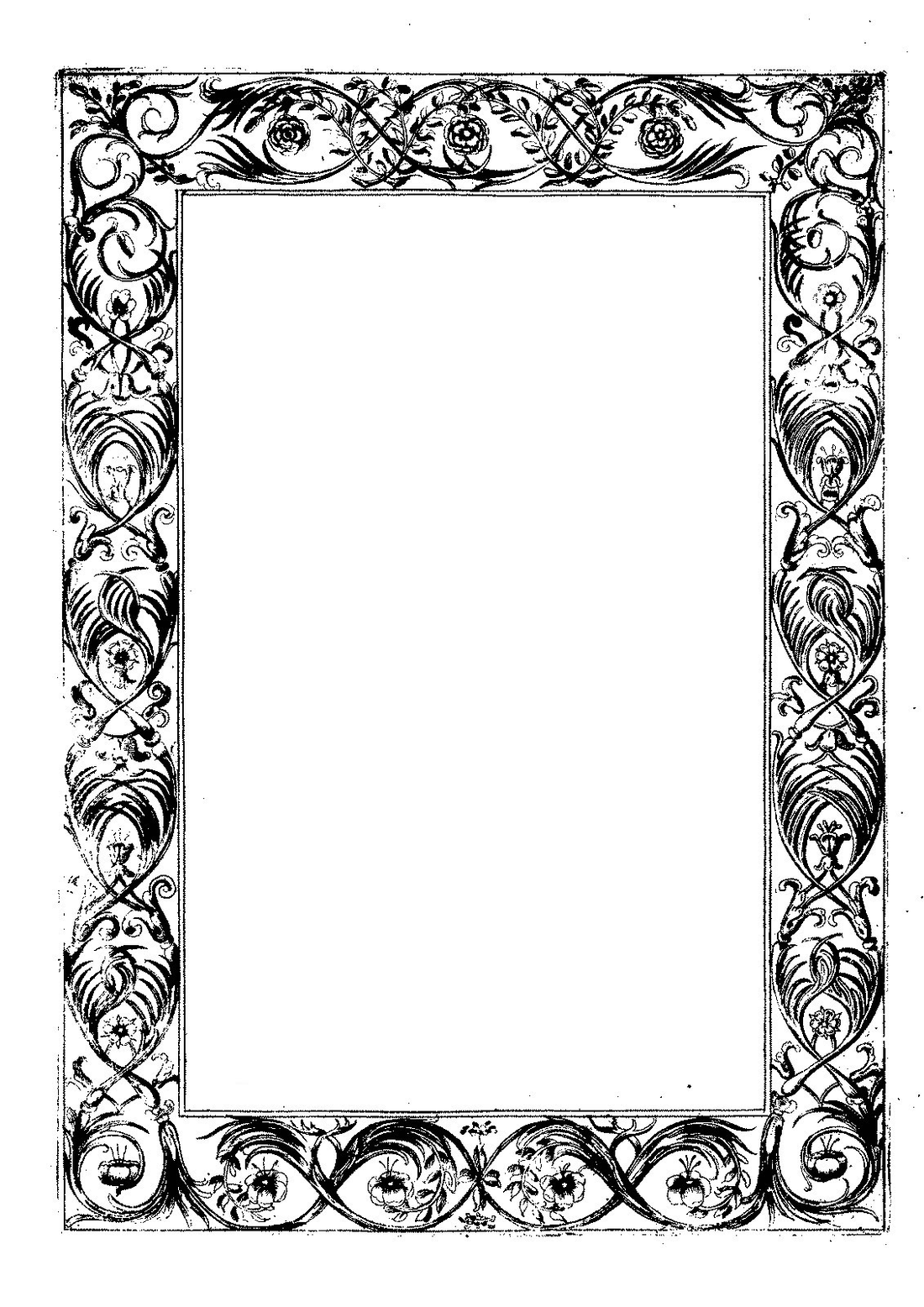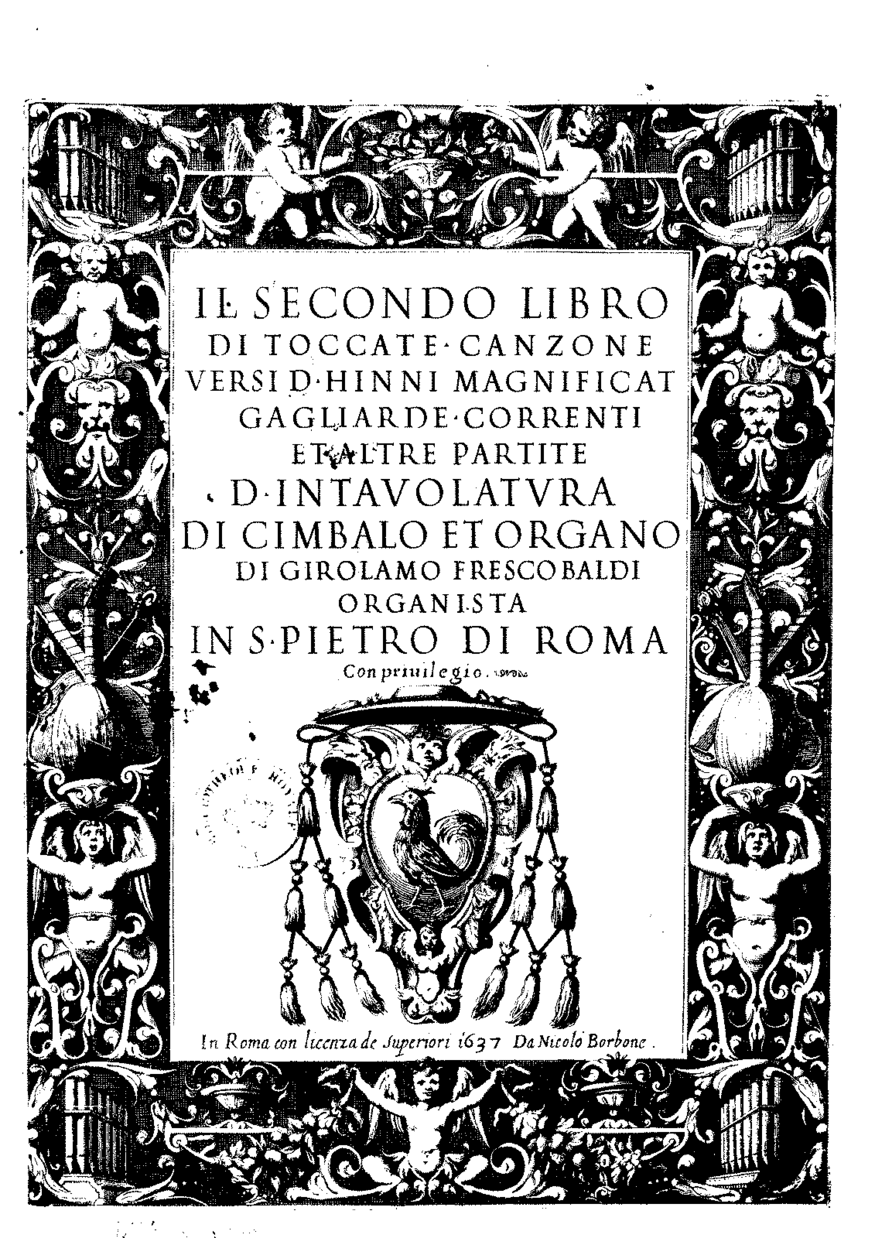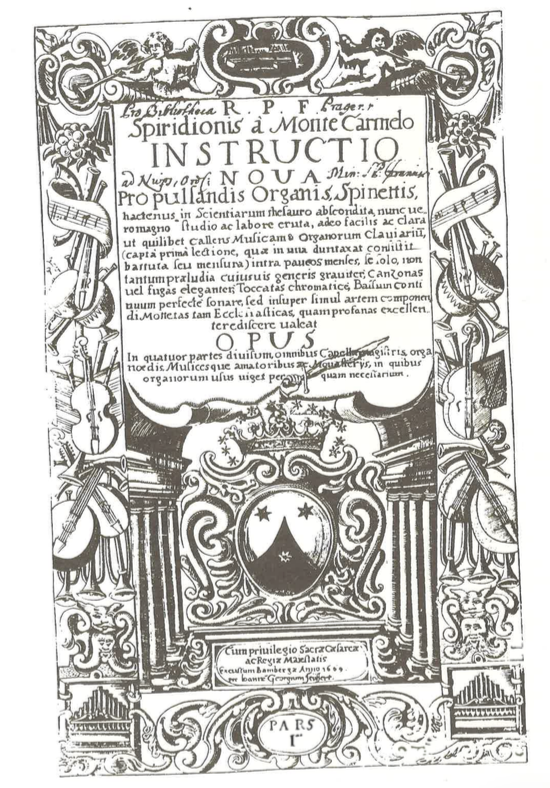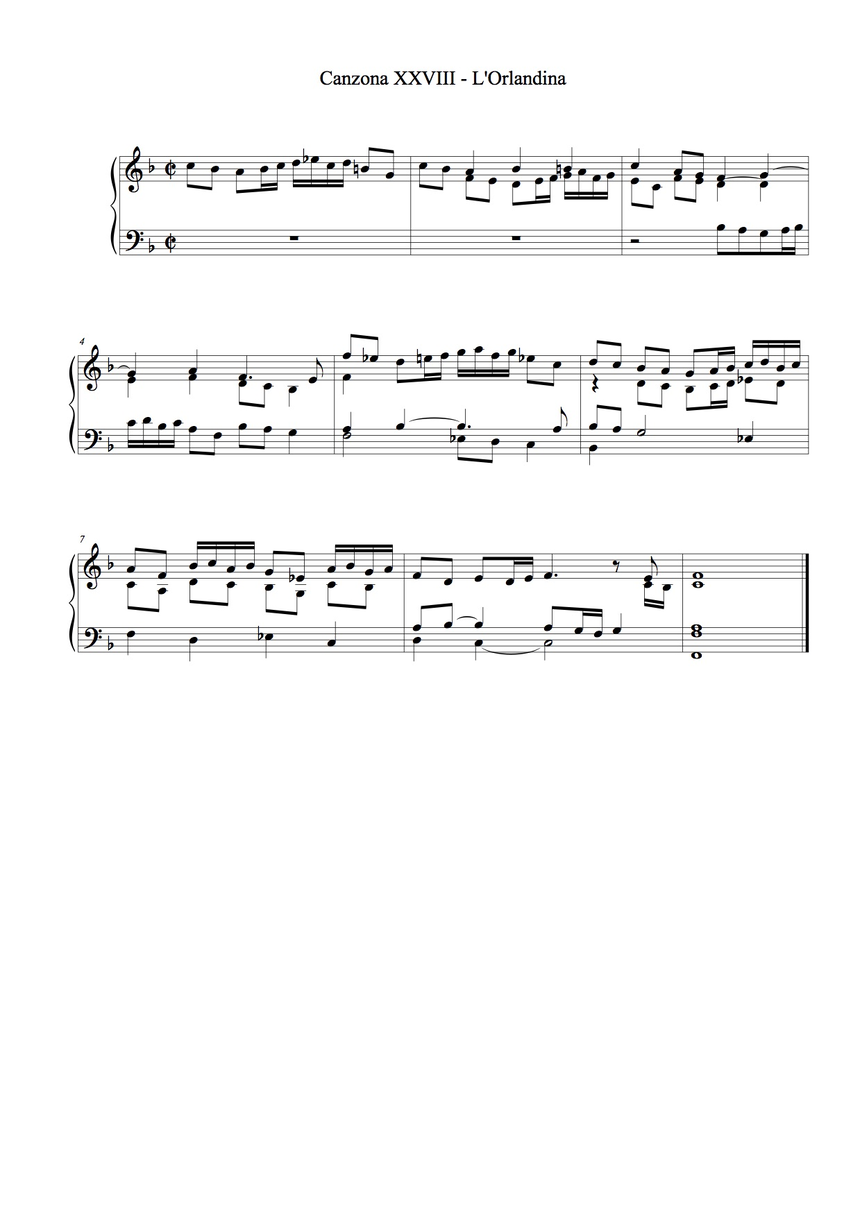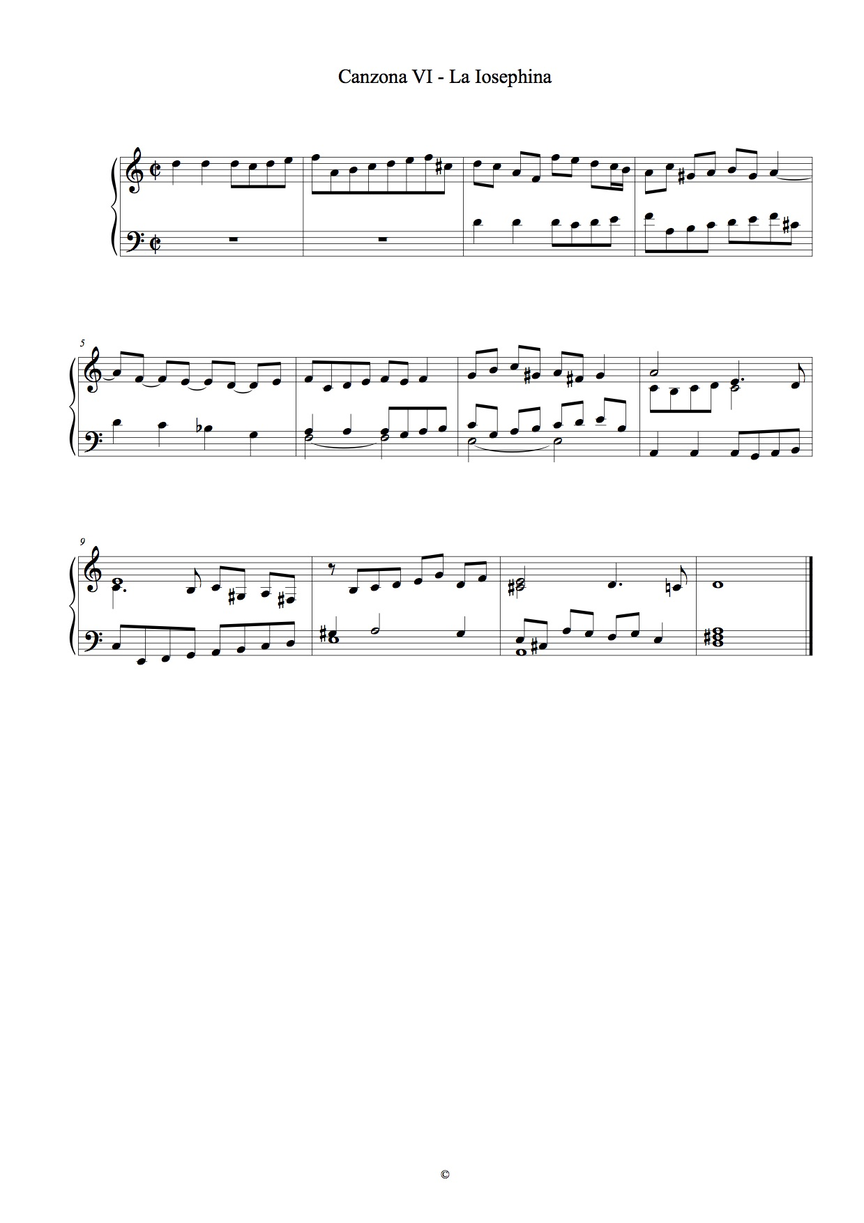4. Development of individual methods
Within the week spent combining the musical fragments of the Nova Instructio on my clavichord, the first obstacle was to structure reasonable practice sessions. The first hypothesis was that each skill mentioned in the preface needs to be exercised equally. Therefore, every practice session was structured in order to get a varied training program including cadenze, passagi and canzoni. Here a typical example of planning for two hours as established before practicing.
1) Choose freely one cadenza, play all the examples through and repeat them immediately from memory.
2) Choose ten variations of this cadenza and transpose through the circle of fifths, as recommended by the author.
3) Same with passaggi, but choosing only three of them.
4) Choose a canzona, copy it and try to recompose the counterpoints.
After the first day, it appeared that passaggi took much more time to learn, which led to a rethinking of the plan. One difficulty was to maintain and refresh daily the memory of previous patterns. The conclusion was that in a week, one has to overlap or program the same cadenza in two distinct work sessions. On the other hand, while practicing, some meta-observations came frequently to mind: I decided to write simultaneously, switching from the keyboard to the pen. Thus, after three days, I decided to practice only one musical form per session, taking care also of all meta-thoughts coming to mind. I also decided to readjust the contents of the practice session to my interior conditions (concentration, state of mind).
Here are the approaches used for each type of musical form:
- Toccata: a short toccata is relatively quick to master, since it is made out of cadentiae and passagia displayed in free order. I decided to play two toccate freely, in the same key (primo tono), before and after a practice session, in order compare their thematic contents. Audio examples of both versions (recorded on a clavichord after M. Praetorius, 1619 by Martin Kather, 2016) can be heard here:
- Canzona: this was the most demanding part, which required writing. I wrote out as an exercise two canzoni of Spiridio reducing them to a “partimento-fugue”, i.e. including only subjects and, where relevant, the lowest voice. The aim was then to complete the missing voices without previously having played the original version. Two versions of the Canzona VI and two of the Canzona XXVIII can be compared in the musical examples 1, 2, 3 and 4 in the following pages (my additions are marked with red ink). In the Canzona VI, Spiridion quotes almost verbatim Frescobaldi (Canzona Prima, Secondo Libro di Toccate, fourth section). Even if I knew the piece and recognised its subject, I did not render the same counterpoint. I did not expect to find fast syncopations (which are common in the volume) or the cadence in the lower octave. On the other hand, the three-voices texture is respected in both versions. The original and “fake” versions of Canzona XXVIII are closer each other, and differences are mostly found in the choice of rhythmical values (as in bar 4).
- Dance and variations: an efficient way to learn to improvise short dances (with particular attention to the rhythmic structure and number of bars), seems to be to play repetitions by heart. This arduous exercise was probably not intended by Spiridio but could be effective for long-term work. Variations on Passagalia, Ciaccona, Ruggero, Monica, Aria di Fiorenza, can easily be built out of patterns. This should, however, be developed further as time restrictions did not allowed me to pursue it further.
- Basso continuo realisation can be practised, too, but not directly with the material. The exercise of realising a three part counterpoint on a bass at first sight is useful for recognising bass motions (cadentiae model) in context and for training reflexes. However, a continuo realisation depends always on the other voices of the composition and cannot be set as freely as a solo improvised piece, which limits the use of the variationes of Spiridio.
3. Interrogations and methodological orientation
Even if it did not capture much attention from musicologists (perhaps because of the fragmentary and rudimentary nature of its musical contents), this method seems very exciting to the performer who discovers it for the first time. Nevertheless, before beginning to use it, a few questions need to be addressed:
- How can the quality of this source be assessed and from which point of view?
- For what type of improvisation is this musical material meant?
- How much of the material can be assimilated in one week of practice?
- Is it really possible to increase fluency in improvisation by working in this way?
- Can pedagogical concepts of the time be reused today?
The understanding of history of ideas by means of practice based on historically grounded methods (making) has received increasing from scientists and art historians in recent decades1. In musical performance, “making” is primary while one might consider “knowing” as ancillary. This attitude has evolved a lot with the so-called historically informed performance practice during the twentieth century, but mainly for performance of written pieces. In the field of style-informed improvisation, or composition at the keyboard (to reuse a terminology by Edoardo Bellotti), this conjunction of making and knowing seems unavoidable.
Consequently, the methodology proposed here involves first the establishment of practice plans and then descriptions of the achieved experiments from a critical point of view. As in any artistic research approach, the researcher is, so to speak, at the same time scientist and test subject.
5. Outcomes
After a week of experimentation, even if a longer timeframe would have produced broader outcomes, conclusions could be summarised as follows:
Source’s general relevancy
- The concept of this method is definitely rooted in practice and does not employ much textual commentary. In this way it is accessible to every keyboard player able to read music. The search for a personal method is needed; rote memorisation of the fragments without incorporating them in a larger structure is ineffective.
- Rapid results can be realistic, provided that the learner has already played and heard a lot of music of that style2.
- Regarding the fluency of extempore improvisation, one must define the intended level and style to attain. The musical material selected is rather designed for playing short, functional intonations and versets in the south-German style than in that of Frescobaldi which is much more unpredictable and often recalls modal patterns.
- A final point that comes to mind after such practice is that improvising or composing at the keyboard necessarily implies technical reflexes: vice versa, hand automatisms can bring new musical ideas. Cadentiae and passaggia idiomatic of the keyboard are thus easiest to integrate, as the gesture serves a kind of cognitive function.
Underlying didactic concepts
- The method suggested by Spiridion is additive and based on repetition. Both aspects seem to be included in best-known memorisation techniques: practice confirms that the repetition of the same cadentia variation in various contexts (transposed and in diverse combinations with other patterns) helps to incorporate it better.
- Although not mentioned by Spiridion, repetition by ear can also be used in an autodidactic context (for example, as an immediate repetition of a fragment after sight-reading).
- Application and assiduity also naturally play a role in the quality and quantity of assimilation.
Benefits...
- The concept of a methodic « musical lexicon », well-known in diminution treatises for melodic instruments, helps to achieve a visual overview of all possible variations.
- The benefits of transposition are also validated by the practice. It is useful to develop it as an independent skill and at the same time to help with memorisation.
- The 72 Passaggi seem to be the most interesting structural elements of the whole compilation and need to be memorised, since they can hardly be improvised at a fast tempo. They can also serve as technical exercises. Simplification and systematisation of frescobaldian passaggia are useful for a faster memorisation.
- The ostinato bass variations, though not mentioned in the title, are suitable for this method, especially those which consists in cadences, like the aria di Ruggero. The same is valid for variations (some small arias and dances included in the compositions part might be intended to that end).
… and limits
- The short canzonas are good models to understand globally how fugal entrances work, but their counterpoint is basic and often based on stereotypes. The lack of counterpoint rules are surely a weak point of the manual.
- In relation to the previous point, it seems relevant to note that the whole method is based only on intavolatura reading, which is considered to be the easiest and direct notation for keyboard instruments. In his Conclusioni sul suono dell’organo (1609), Adriano Banchieri lists the four main skills required for an organist: Fantasia (improvisation), Partitura (4-part score reading), Intavolatura (two systems notation reading) and Basso (thorough-bass realisation)3. In the preface of his Fiori Musicali (1635) Frescobaldi presents the ability to read scores as a mark of superiority for organists: “[…] I consider the ability to read scores essential for players, not only because I consider it necessary for whoever wishes to dedicate himself to such compositions, but equally necessary because this skill reveals and distinguishes the real gold from the virtuoso motions of the ignorant.” The 4-part partitura was used by Froberger in his Viennese manuscripts and even by Gottlieb Muffat in the second half of the eighteenth century, but does not seem concerned with versets and small musical pieces for liturgical use. S.A. Scherer, in his organ works published in Ulm in 1664, chooses the intavolatura for the small versets and the partitura for the largest elaborated pedal toccatas.
References
a) Sources
ANONYMUS (1668), Orgelschule Wegweiser, modern edition by R. Walter, Musikverlag Alfred Coppenrath, Altötting 1964.
ADLUNG, Jakob, Anleitung zu der musikalischen Gelahrtheit, 1758, Faksimile ed. By Hans Joachim Moser, Bärenreiter, Kassel 1943.
PENNA, Lorenzo, Li primi albori musicali, Bologna, 1679, transcription of Bernhard Lang, http://www.bassus-generalis.org/penna/penna.html (14.12.2017).
SPIRIDIO a Monte Carmelo (NENNING, Johann), Nova Instructio pro Pulsandis Organis Spinettis Manuchordiis &c. Pars Prima (Bamberg 1670)[and] Pars Secunda (Bamberg 1671), modern edition by Edoardo Bellotti, Andromeda Editrice, Colledara, 2005.
Idem, Nova Instructio pro Pulsandis Organis Spinettis Manuchordiis &c. Pars Tertia & Quarta (Würzburg: J. Sallver, ca. 1675-77), modern edition by Edoardo Bellotti, Il Levante Libreria Editrice, Lattina, 2008.
b) Literature
BELLOTTI, Edoardo , “Composing at the keyboard: Banchieri and Spiridion, two complementary methods” in Massimiliano Guido (ed), Studies in Historical Improvisation: From Cantare super Librum to Partimenti, Routledge, New York 2017.
BELLOTTI, Edoardo, L’arte di sonar di Fantasia. L’improvvisazione alla tastiera in Italia nei secoli XVI-XVIII, « Rivista Internazionale di Musica Sacra », XXI, 2000/1, pp. 93-145.
CALLAHAN, Michael, Techniques of keyboard improvisation in the German Baroque and their implications for today's pedagogy, Ph. D., Rochester University 2010.
LAMOTT, Bruce Alan, Keyboard Improvisation according to « Nova Instructio pro pulsandis Organis (1670 ca., 1675) by Spiridion a Monte Carmelo, Ph. D., Stanford 1980.
SMITH, Pamela, “Nature and Art, Making and Knowing: Reconstructing Sixteenth-Century Life-Casting”, Renaissance Quarterly, Vol. 63, No. 1 (Spring 2010).
2. Context
The German Carmelite Johann Nenning (1615-1685), also known as Spiridion a Monte Carmelo, earned his reputation mainly through his musical publications: Musica Romana, Bamberg, 1665 (a collection of motets of various Roman composers), Musica Theo-Liturgica, Würzburg, 1668 (five-voices masses of his own composition) and the Nova Instructio pro pulsandis organis, Bamberg 1670-1674. Biographical information comes mainly from the title pages and dedications of these works, but also from articles in music dictionaries (from Kaspar Prinz, 16906 to Fétis, 1876 and Riemann, 1882), as well as from research by a few german historians in the beginning of the twentieth century7. The first extensive research about the Nova Instructio was lconducted by Bruce A. Lamott in his dissertation (Stanford, 1980)8. Important biographical data mentioned about Spiridion are mainly his birth in Neustadt an der Saale in 1615, his stay in Rome from 1643 to 1655 (during the Thirty Year War) where he probably acted as organist of the Collegium Germanicum, and his occupations in the Carmelite convent of Bamberg from 1655 to his death. There, a university was founded by the Jesuits in 1647, and the city could grow again after the disasters caused by the war. All the musical activities of Spiridion seem to be linked to the monastic milieu, although in Rome, after Frescobaldi’s death, Giacomo Carissimi attracted many German students such as J.K. Kerll and J.E. Kindermann and established a circle of musicians of various provenances.
The Nova Instructio consists of four engraved volumes: the first two were printed in Bamberg in 1670 and 1671 by J.J. Immel and J.G. Seyfert, whereas the last two parts, edited in Würzburg by J. Sallver a few years later (1676-77), are now lost. An entire manuscript copy of the four bands survives however in the Sächsische Landesbibliothek of Dresda (MB 4 f217)9. The rich frontispiece of the first band (see fig. 1) strongly resembles to the one of Frescobaldi’s Secondo Libro di Toccate, engraved by Nicolò Borbone in Rome about thirty years earlier (see fig. 2). This first allusion to Frescobaldi’s engraved publications gives a foretaste of the contents of the work, wherein the figure of the “monster of organists” (as Luigi Battiferri used to call him10) is omnipresent. The complete title appears as follows:
“ SPIRIDION a Monte Carmelo / New and hitherto unknown instruction / How one may not only completely attain in a short time, consummate skill in organ and keyboard-playing but also in the art of composition; thus easy and clear, so that whoever understands music and the keyboard and comprends well the first lesson (which can be grasped in only a measure or battuta) can thereafter by himself play diverse preludes, canzonas or fugues, toccatas, and thorough-bass in a few months without any difficulty, and can fully master and practice the art of composition / Divided in Four Parts / Highly necessary to all choirmasters, organists, and lovers of music, as well as monasteries which use the organ. / First Part Bamberg / Printed in the princely press by Johann Jacob Immel / In the year 1670.11”
The same text is taken for the frontispiece of the third and fourth volumes, with an additional sentence « […] in addition of that, how to master the art to compose sacred and secular motets ». This complement is notable in regard to the contents of the two last bands which include canonic patterns, which were very common in church music of the second half of the century. The title, in its style, seems designed for commercial needs; in any case, it presents exhaustiveness and approachability as central concepts. As already mentioned, the possible use of the handbook by autodidacts is a notable feature.
After a dedication (with a clear mention of the work’s primary destination for convents), the first volume contains a two-pages preface constituting almost the only textual content of the method. Eleven bilingual points in Latin and German offers the reader methodological advice and instructions for performance practice. The first points are personal and help the player to deal with the contents of the manual, while the second come directly from Frescobaldi’s Primo Libro di Toccate (Roma, 1615). First, Spiridion suggests choosing cadences from his anthology, starting from the easiest, and insists on transposition into all keys. This should not only be a tool for learning how to conclude musical phrases, but also a helpful exercise to develop fluent transposition of the basso continuo parts. One should keep in mind that transposition was probably much more necessary in the musical practice of the time than today. The next points enunciate further guidelines: how to connect single musical elements one to each other, how to take care of rhythmical issues in the juxtaposition of fragments, how to maintain variety by choosing different patterns, as well as very basic counterpoint rules such as the contrary motion principle. Regarding performance, the author warns the player not to perform passaggi too quickly and suggests stopping on the last note of them, exactly like Frescobaldi has explained in his Avvertimenti. What follows is a wide anthology of musical building-blocks: variations on bass motions called cadentiae, movements of both hands, often in parallel eighth-notes called passaggia, and short compositions such as canzoni and dances. The quality and complexity of the material are variable, as well as the stylistical appartenance. Besides Frescobaldi’s quotations, a significant part of the examples sound quite systematic and thus modern for the time. Some of them are poor and rudimentary compared to compositions of Frescobaldi and his contemporaries.
Solo organ music had a central role in the liturgy of daily offices, masses and vespers; its interventions consisted mainly of introit- and elevation-toccatas, alternatim verses and canzonas. Frescobaldi’s Fiori Musicali (1635) was considered as a model for that repertoire and inspired similar collections in Italy (Antonio Croce’s Frutti Musicali, 1642 and Giovanni Battista Fasolo’s Annuale, 1645). Towards the Alps, collections of versets (like Sebastian Anton Scherer’s Tabulatura 1664 and Johann Speth’s Ars Magna consoni et dissoni, 1693) were preferred to masses. In both countries, however, as church services were often held daily, improvisation probably constituted the reality of musical practice.
Some manuscripts from German-speaking areas are even directly linked to the Nova Instructio. For example, a source located in the Bibliothèque Nationale de France, Paris (Vm7 1817, Brossard collection12) contains some canzonettas of Spiridion as well as basic intonations who seem to come from his cadentiae. Likewise, in Vienna, a source of eight hundred organ verses (Minoritenkonvent Abt. XIV n°684), property of Pater Alexander Giessel (1694-1766), includes some of Spiridion’s cadentiae, as well as many compositions from Frescobaldi to Gottlieb Muffat.
The Nova Instructio deserves a special place within this context since it contains practically all the features to build an unlimited number of pieces for liturgical use. It is a real toolbox which, if used properly, could help to spare thousands of sheets of paper and liters of ink.
6. Conclusion
An intensive confrontation with a source like Spiridion’s Nova Instructio helped to develop skills at two different levels: first, increasing « musical vocabulary » (or knowledge) and second, after the experimental phase, provoking new questions about improvisation didactics in general (reflection). Selecting, compiling and reusing ideas of admired masters in a personal practice seems to be a central and natural strategy in music learning processes, which persists in the following century with Johann Ernest Eberlin and Jakob Adlung who used to call it poetically “Blumenlese” (flower picking)13.
In our context of frescobaldian legacy, Lorenzo Penna14 expressed it as follows in 1679:
“I do not need to teach the student in this profession how to respond to the choir during mass, vespers, compline, nor other things concerning the cantus firmus; there are plenty of ricercari, toccate, canzoni, capricci, etc. by talented men such as Urbino da Bologna, Luzasco Luzaschi, Girolamo Frescobaldi and others, that I do not need to be extensive. I therefore suggest that beginners study the authors mentioned, and in particular Girolamo Frescobaldi, who was the model of his time in this profession; furthermore, by becoming acquainted with his second book, the student will be able to write versetti, toccata, canzoni, etc. himself”.
That would perhaps encourage the twenty-first-century organ and harpsichord improviser to make his own catalogue of figures according to his taste and personal preferences, thereby becoming an actor and establishing a dialogue with the musical text. In this way, he himself can establish new uses for this material, that are adapted to present conditions of teaching and performance.
